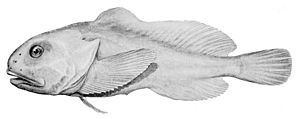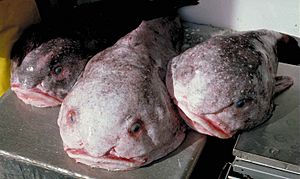Blobfish facts for kids
The blobfish is a fascinating deep-sea fish. Its scientific name is Psychrolutes marcidus. You can find blobfish mainly in the deep waters near Australia, Tasmania, and New Zealand. They live very far down, usually between 610 to 1,220 meters (about 2,000 to 4,000 feet) below the surface. At these depths, the water pressure is much, much higher than on land. Blobfish are part of a fish family called Psychrolutidae.
Contents
What Does a Blobfish Look Like?
Blobfish have a very unique look. Their bodies are soft and jelly-like. Unlike many fish, they do not have a swim bladder. A swim bladder is an organ that helps fish float. Instead, the blobfish's body is slightly lighter than water. This lets them float easily just above the ocean floor.
Most blobfish are less than 30 centimeters (about 12 inches) long. They are usually grayish or whitish-pink in color. They also have large eyes and a bulbous, or rounded, head.
Where Do Blobfish Live?
Blobfish are true deep-sea dwellers. They live in the abyssal and bathyal zones of the ocean, which are characterized by extreme conditions:
- Depth: They are typically found at depths ranging from about 600 meters (2,000 feet) down to 2,800 meters (9,200 feet). Some species, like Psychrolutes marcidus, are commonly found between 600 and 1,200 meters (2,000 to 3,900 feet).
- Location: These fish inhabit the cold waters of the Atlantic, Pacific, and Indian Oceans. Specific species are found in different regions; for example, Psychrolutes marcidus is found off the coasts of Australia, Tasmania, and New Zealand, while Psychrolutes phrictus lives in the North Pacific.
- Pressure: The most defining feature of their habitat is the immense pressure. At 1,000 meters deep, the pressure is about 100 times greater than at the surface! This extreme pressure is why blobfish have evolved their unique bodies.
- Temperature: The deep sea is consistently cold, often just a few degrees above freezing.
- Light: Sunlight cannot penetrate these depths, so their environment is completely dark.
Living in such an extreme environment requires incredible adaptations, which is what makes the blobfish so fascinating to scientists.
How Do Blobfish Live and Eat?
Blobfish are not fast swimmers. They save their energy by waiting for food to come to them. This is called a "passive feeding strategy."
Their diet includes:
- Small crustaceans: Tiny shrimp-like creatures that live on the seafloor.
- Sea pens: Colonial animals that resemble old-fashioned quill pens.
- Other organic matter: Any edible detritus (dead plants and animals) that sinks down from the upper layers of the ocean, often called "marine snow."
Because they do not have much muscle, they use very little energy. This helps them survive in the cold, deep ocean.
Reproduction
Not much is known about their reproduction, as observing them in their natural habitat is extremely difficult. However, some deep-sea sculpins (which blobfish are a type of) are known to lay large numbers of eggs on the seafloor. There's even some evidence suggesting that female blobfish might guard their nests, sitting on their eggs to protect them from predators, which is a rare behavior for deep-sea fish. This parental care helps ensure the survival of their offspring in a harsh environment.
"Mr. Blobby"
One particular specimen of ''Psychrolutes microporos'' became a global sensation and is largely responsible for the blobfish's fame. This individual, affectionately nicknamed "Mr. Blobby," was discovered in 2003 during a research expedition off the coast of New Zealand. It was found at a depth of about 1,300 meters (around 4,265 feet) on the Norfolk Ridge.
When Mr. Blobby was brought to the surface, the drastic change in pressure caused its body to expand and lose its structural integrity, giving it the iconic "blob-like" appearance that made it famous. This image quickly spread across the internet.
Are Blobfish in Danger?
As of 2025, they are not considered endangered.
However, blobfish can be caught by accident in deep-sea fishing nets. These nets are used to catch other sea animals. Scientists believe that blobfish populations might be vulnerable. This means they could be at risk because of overfishing. Overfishing can harm their homes deep in the ocean.
The Blobfish Family: More Than Just One Fish!
Here's a breakdown of the main species and groups commonly referred to as blobfish:
Psychrolutidae (The Blobfish Family): This is the scientific family that most blobfishes belong to. They are often called "fatheads" or "sculpins" and are characterized by their soft, gelatinous bodies and large heads.
- Psychrolutes microporos (The Fathead or Classic Blobfish): This is arguably the most famous blobfish species, often simply called "a blobfish" or "fathead."
- Psychrolutes marcidus (The Smooth-head Blobfish): Another well-known species, often simply referred to as a blobfish. It shares many characteristics with P. microporos, including its deep-sea habitat and gelatinous body.
- Psychrolutes occidentalis (The Western Blobfish or Western Australian Sculpin): As its name suggests, this species is found in the waters off Western Australia. It's another member of the Psychrolutes genus, adapted to similar deep-sea conditions.
- Psychrolutes phrictus (The Blob Sculpin): Also commonly known as a blobfish, this species is found in the North Pacific Ocean. It's another example of a fish that has evolved a soft, buoyant body to thrive in high-pressure environments.
- Ebinania (A Genus of Fish): This genus also belongs to the Psychrolutidae family and includes several species that are often referred to as blobfish or "fathead sculpins." They share the characteristic deep-sea adaptations and appearance of their relatives.
Why Are Blobfish Important?
While they might seem unusual, blobfish play a role in the deep-sea ecosystem and are incredibly valuable to science.
As scavengers, blobfish help to recycle nutrients in the deep ocean. They consume organic matter that sinks to the seafloor, preventing it from accumulating and helping to keep the deep-sea environment clean. They are part of a complex food web, even if they are not at the top.
Studying blobfish and other deep-sea creatures helps scientists understand how life can adapt to extreme conditions. Their unique physiology provides insights into:
- Evolutionary biology: How species evolve to survive in specific niches.
- Biophysics: The physical properties of biological materials under extreme pressure.
- Oceanography: The dynamics of deep-sea environments and the impact of human activities.
- Biodiversity: They represent a unique branch of biodiversity, reminding us that life on Earth is incredibly diverse and can thrive in places we might least expect.
Fun Facts About Blobfish
- The blobfish gained international fame after being voted the "World's Ugliest Animal" in 2013.
- They have never been observed in their natural habitat by humans.
- When people talk about "the blobfish," they often picture one specific image, but the term actually covers a group of related fish.
- "Mr. Blobby" belongs to Psychrolutes microporos species.
- The blobfish's famous "blob" shape is not how they look underwater. When they are brought up from the deep ocean too quickly, their soft bodies change. The huge drop in water pressure makes them collapse. This is why they look like a "blob" when seen on land. But underwater, they look more like a typical fish.
See also
- Psychrolutidae, the family of fish that blobfish belong to
- Psychrolutes microporos, also known as a blobfish or fathead, famous from a well-known photo
- Psychrolutes marcidus, often called the smooth-head blobfish or simply a blobfish
- Psychrolutes occidentalis, known as the Western blobfish
- Psychrolutes phrictus, the blob sculpin, another fish often called a blobfish
- Ebinania macquariensis, the Macquarie blobfish




